U.S. Manufacturing Economy
Applied Economics in US Manufacturing

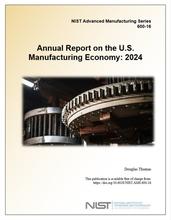
SUMMARY: In terms of value added, the primary measure of economic activity, the U.S. is the second largest manufacturing nation in the world behind that of China. The U.S. ranking as a brand suggests that it tends to be a differentiator rather than a cost competitor; however, a number of nations rank higher as a brand. In terms of value added, the largest subsectors of manufacturing are chemical products; food, beverage, and tobacco products; and computer and electronic products, as shown in Figure 2.9 and Figure 2.10 of NIST AMS 600-16.
There are three primary aspects of examining U.S. manufacturing statistics on competitiveness: (1) how the U.S. industry compares to other countries, (2) the trends in the domestic industry, and (3) the industry trends compared to those in other countries. NIST AMS 600-16 provides statistics on these aspects. Below are highlights from this publication. Due to the necessity to use a selection of datasets, there may be minor discrepancies between various statistics. Additional data and statistics can be estimated using NIST’s Manufacturing Cost Guide.
Manufacturing in Brief
Some brief figures on U.S. manufacturing include the following:
- In 2023, Manufacturing contributed $2.3 trillion to U.S. GDP amounting to 10.2 % of total U.S. GDP, measured in chained 2017 dollars, according to BEA data.
- Direct and indirect (i.e., purchases from other industries) manufacturing value added contributed an estimated 17.1 % of GDP (see Table 3.2 of AMS 600-16).
- According to the Current Population Survey, there were 15.6 million employees in U.S. manufacturing in 2023, representing 9.7 % of total U.S. employment.
U.S. as a Brand
Frequently, countries are discussed as brands. Two rankings provide insight into the U.S. as a brand:
- U.S. ranks 6th in the Ipsos National Brands Index
- U.S. ranks 10th among 49 total countries in Statistica’s Made-in-Country Index
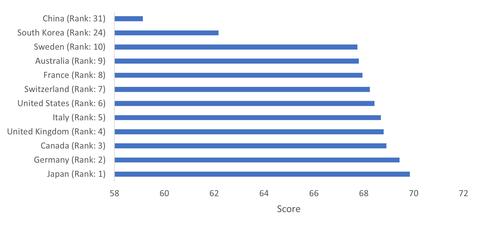
Ipsos National Brands Index, 2023
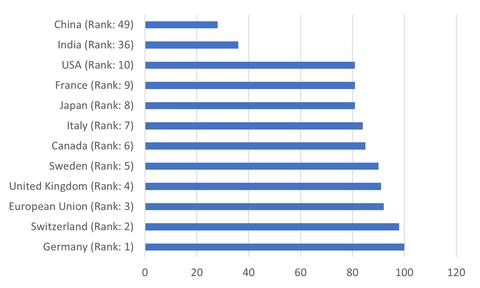
Made-in-Country Index, 2017
Inflation
Inflation has increased in recent years, which diminishes purchasing power.
- The prices received by producers for all manufacturing between July 2020 and July 2022 increased 33.4 %
- For context, in the fifteen years prior to that (i.e., June 2005 to June 2020) it increased 27.1 % in total
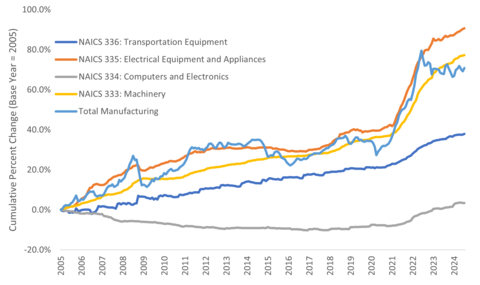
Inflation - Cumulative Percent Change in the Producer Price Index (Selling Price Received), 2005-2024
Manufacturing Growth
- U.S. compound real (i.e., controlling for inflation) annual growth between 1997 and 2022 (i.e., 25-year growth) was 1.7 %, which places the U.S. below the 50th percentile.
- The compound annual growth for the U.S. between 2017 and 2022 (i.e., 5-year growth) was 1.5 %. This puts the U.S. just below the 50th percentile and below the world average of 2.9 %.
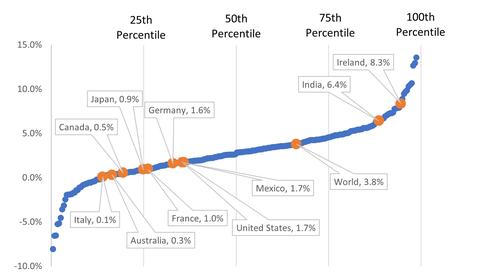
National 25-Year Compound Annual Growth, by Country (1997 to 2022): Higher is Better
Manufacturing Industry Size
- In 2022, manufacturing accounted for 17.5 % of global GDP
- Since 1970, global manufacturing ranged between 13.7 % and 17.5 % of global GDP
- U.S. manufacturing value added, as measured in constant 2015 dollars, is 15.1 % of global manufacturing value added putting it second to that of China, which is 31.0 %.
- Among the ten largest manufacturing countries, the U.S. is the 2nd largest manufacturing value added per capita while China ranked 5th. Out of all countries the most recent U.S. rank is 16th
- Out of the total 11 manufacturing subsectors, the U.S. ranked 1st in two subsectors and 2nd in the remaining nine.
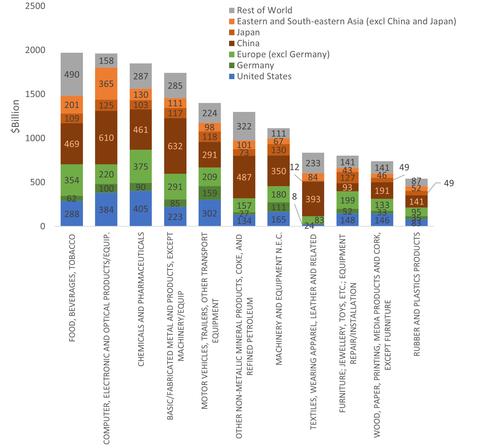
Global Manufacturing Value Added by Industry, by Country/Region (2020)
Productivity
- The five-year annual compound growth in labor productivity is 0.4 %.
- The five-year annual compound growth in multifactor productivity is less than 0.1 %.
- The U.S. is ranked 9th in output per hour among 142 countries using data from the Conference Board.
- In 2022, Manufacturing total factor productivity was 0.5 % above its 2005 level.
- In 2022, durable goods was 6.7 % above its 2005 level.
- In 2022, nondurable goods was 4.3 % below its 2005 level.

Manufacturing Total Factor Productivity Index
Economic Environment
There is no agreed upon measure for examining the environment for research, innovation, and other factors for doing business, but there are a number of common measures, which are discussed below.
- The ranking of the U.S. in these measures mixed, ranking high in some and lower in others.
- The U.S. ranks
- 4th in 2020 patent applications
- 3rd in 2020 research and development expenditures as a percent of GDP
- 18th in 2019 researchers per million people
- 24th in 2020 journal article publications per capita.
- Competitiveness indexes
- The 2023 IMD World Competitiveness Index, which measures competitiveness for conducting business, ranked the U.S. 9th
- The World Economic Forum, which assesses the competitiveness in determining productivity, ranked the U.S. 2nd in 2019.
- The Competitive Industrial Performance Index, which measures capacity to produce and export manufactured goods; technological deepening and upgrading; and world impact, ranked the U.S. 5th.
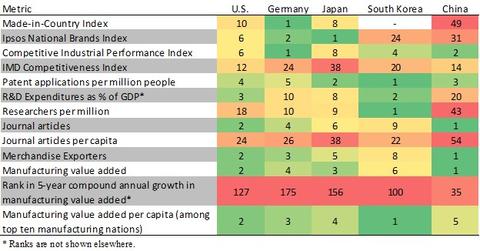
Rankings for a Selection of Metrics and Countries (Lower is Better)
Types of Goods Produced
The largest manufacturing subsector in the U.S. is chemical manufacturing followed by and food, beverage, and tobacco products with computer and electronic products being 3rd.
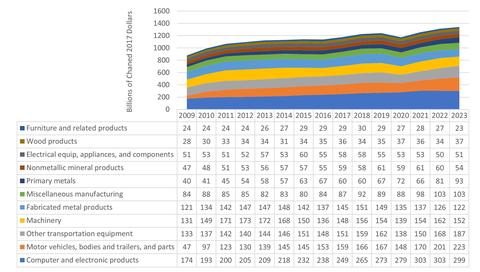
Value Added for Durable Goods by Type (billions of chained dollars), 2009-2023
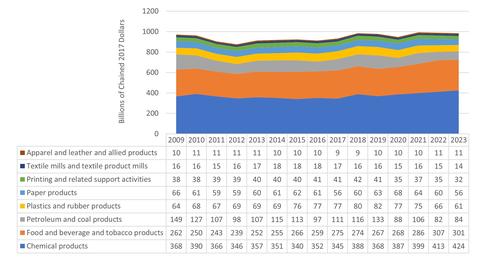
Value Added for Nondurable Goods by Type (billions of chained dollars), 2009-2023
Manufacturing Safety, Compensation, and Profit
- Compensation
- As illustrated in Figure 4.5, employee compensation, which includes benefits, has had a five-year compound annual growth of -1.9 %.
- Profit
- Nonfarm proprietors’ income for manufacturing has had a five-year compound annual growth rate of 14.9 %.
- Corporate profits have had a five-year compound annual growth of 11.1 %.
- Safety
- Fatalities have a five-year compound growth rate of 5.9 %.
- Injuries have a five-year compound growth rate of -1.5 %.
- The injury rate has a five-year compound growth rate of -1.8 %
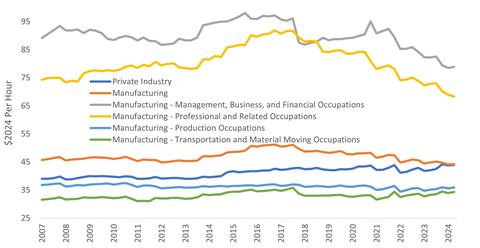
Employee Compensation (Hourly)
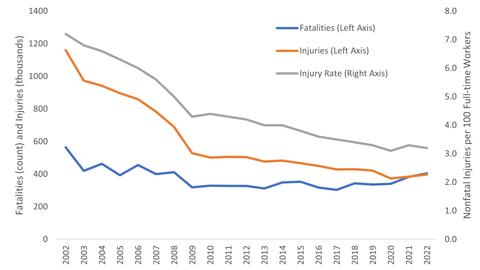
Manufacturing Fatalities and Injuries
Manufacturing Assets and Supply Chain
- In 2022, U.S. manufacturing imported 20.6 % of its intermediate goods/services, resulting in 13.4 % of the output being of foreign origin.
- The largest supply chain entity for U.S. manufacturing by country is itself (83.0 %) followed by Canada (3.1 %), China (1.8 %), and Mexico (1.5 %).
- In 2022, the U.S. manufacturing industry net stock for equipment, structures, and intellectual property were $1.8 trillion, $2.0 trillion, and $1.9 trillion, respectively.
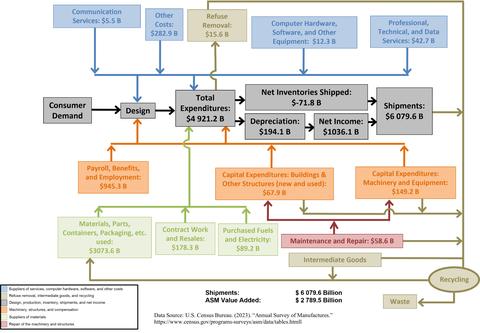
Manufacturing Supply Chain, 2021
For more information, please see NIST AMS 600-16.
Contacts
-
(301) 975-4918

